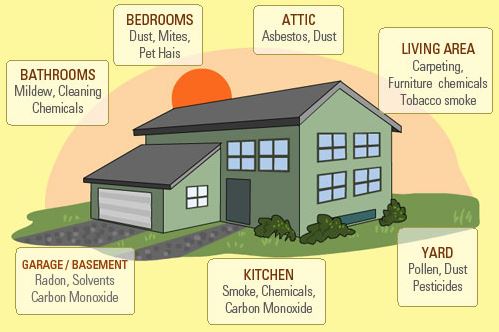
The health effects can range from mild fatigue to severe respiratory distress and death. There may not be a silver bullet—or at least a cost-effective one—to eliminate all indoor air pollution at your lake home, but looking at these six steps, big and small, will set you on the right path to a healthy home environment.
Install Adequate Ventilation
This latest concern for indoor air pollution is a side effect of better energy-efficiency. Modern homes can trap too much air inside your home and reduce air circulation. The solution is not to return to higher utility bills and greater energy consumption but better ventilation. Bathrooms, basements, and attics are the big problem areas, but anywhere can present considerable indoor air pollution without some degree of ventilation.
Know What’s in your Air

You have to test your air. There may be things you can’t see or smell. Not everything that does smell is pollution. Take, for example, radon. Rising up through the ground, this radioactive gas can infiltrate your home through joints, plumbing, and other cracks in your home. It is the second leading cause of lung cancer. You can’t smell this gas, but it can be accurately identified with an inexpensive testing kit. That said, you probably want more a comprehensive assessment of your indoor air quality completed by a qualified professional. You can’t prevent indoor air pollution, if you don’t know what’s in the air.
Reduce and Alter Indoor Chemical Use
Household cleaners and pesticides are full of chemicals. In some cases, people can be bothered by low levels of these chemicals. Ironically, indoor air is now recognized as being full of many of the same chemicals we’ve spent so much time reducing outdoors. Pay close attention to the labels on household products. If possible, switch to natural products that contain fewer toxic chemicals. When you do need to use a stronger chemical, use it sparingly and follow all the precautions explained on the label. Also be careful about what you inadvertently bring into the home, such as recently dry-cleaned clothes, which can emit a number of harmful chemicals.
Use More Sophisticated Furnace Filters
The traditional furnace air filter isn’t designed to clean air. Its only function is to keep large particles, like hair and debris, from damaging the furnace blower. These larger particles are rarely the source of human breathing difficulty. Now there are new, more elaborate filters on the market that trap enough particulate matter to help humans breathe better. In general, the more costly the filter, the more dust it snags out of the airflow. Costing anywhere from $600 to $1,300, whole house air filters can pull out up to five times as many particles as traditional filters. Having the ductwork for your furnace and/or air conditioning system thoroughly cleaned may also reduce indoor air pollution, and may increase the productivity of your system, too.
Install an Electronic Air Cleaner
Electronic air cleaners can extract 30 times as much dust as ordinary filters, but they cost a lot more. In fact, a professionally installed air cleaner costs $500 to $700. While this is a substantial amount of money, it’s worth every penny if it offers significant breathing relief to one or more people in your household. If the price is too steep for you, portable units can be purchased for far less. Of course, the smaller units clean just the air in one room (much like a window air conditioner cools only one room). Electronic air cleaners only need to be cleaned once a year or so because they incinerate the trapped dust.
Reduce Indoor Air Pollution Naturally with Houseplants
Plants can do a great job of helping to remove toxins from the home. The nice thing about plants is that, while they are effective in reducing indoor air pollution, they don’t look out of place or create noise. Some plants work harder than others. A few that have been shown to work well: Boston fern, spider plant, English ivy, areca palm, and peace lily. A good rule of thumb is two plants per hundred square feet.
Original Post by HomeAdvisor.com
Re-posted by Scott Freerksen “The Lake Guy”
